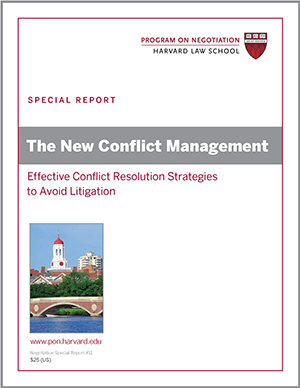
If you work with others, sooner or later you will almost inevitably face the need for conflict resolution. You may need to mediate a dispute between two members of your department. Or you may find yourself angered by something a colleague reportedly said about you in a meeting. Or you may need to engage in conflict resolution with a client over a missed deadline. In organizations, conflict is inevitable, and good conflict management tools are essential.
What is conflict resolution, and how can you use it to settle disputes in your workplace?
Conflict resolution can be defined as the informal or formal process that two or more parties use to find a peaceful solution to their dispute.
A number of common cognitive and emotional traps, many of them unconscious, can exacerbate conflict and contribute to the need for conflict resolution:
• Self-serving fairness interpretations. Rather than deciding what’s fair from a position of neutrality, we interpret what would be most fair to us, then justify this preference on the bases of fairness. For example, department heads are likely to each think they deserve the lion’s share of the annual budget. Disagreements about what’s fairlead to clashes.
• Overconfidence. We tend to be overconfident in our judgments, a tendency that leads us to unrealistic expectations. Disputants are likely to be overconfident about their odds of winning a lawsuit, for instance, an error that can lead them to shun a negotiated settlement that would save them time and money.
• Escalation of commitment. Whether negotiators are dealing with a labor strike, a merger, or an argument with a colleague, they are likely to irrationally escalate their commitment to their chosen course of action, long after it has proven useful. We desperately try to recoup our past investments in a dispute (such as money spent on legal fees), failing to recognize that such “sunk costs” should play no role in our decisions about the future.
• Conflict avoidance. Because negative emotions cause us discomfort and distress, we may try to tamp them down, hoping that our feelings will dissipate with time. In fact, conflict tends to become more entrenched, and parties have a greater need for conflict resolution when they avoid dealing with their strong emotions.
Given these and other pitfalls, how can you set up a constructive conflict resolution process when dealing with conflict at work and other realms? Conflicts can be resolved in a variety of ways, including negotiation, mediation, arbitration, and litigation.
• Negotiation. In conflict resolution, you can and should draw on the same principles of collaborative negotiation that you use in dealmaking. For example, you should aim to explore the interests underlying parties’ positions, such as a desire to resolve a dispute without attracting negative publicity or to repair a damaged business relationship. In addition, determine your best alternative to a negotiated agreement, or BATNA—what you will do if you fail to reach an agreement, such as finding a new partner or filing a lawsuit. By brainstorming options and looking for tradeoffs across issues, you may be able to negotiate a satisfactory outcome to your dispute without the aid of outside parties.
• Mediation. In mediation, disputants enlist a trained, neutral third party to help them come to a consensus. Rather than imposing a solution, a professional mediator encourages disputants to explore the interests underlying their positions. Working with parties both together and separately, mediators seek to help them discover a resolution that is sustainable, voluntary, and nonbinding.
• Arbitration. In arbitration, which can resemble a court trial, a neutral third party serves as a judge who makes decisions to end the dispute. The arbitrator listens to the arguments and evidence presented by each side, then renders a binding and often confidential decision. Although disputants typically cannot appeal an arbitrator’s decision, they can negotiate most aspects of the arbitration process, including whether lawyers will be present and which standards of evidence will be used.
• Litigation. In civil litigation, a defendant and a plaintiff face off before either a judge or a judge and jury, who weigh the evidence and make a ruling. Information presented in hearings and trials usually enters the public record. Lawyers typically dominate litigation, which often ends in a negotiated settlement during the pretrial period.
In general, it makes sense to start off less-expensive, less-formal conflict resolution procedures, such as negotiation and mediation, before making the larger commitments of money and time that arbitration and litigation often demand. Conflict-resolution training can further enhance your ability to negotiate satisfactory resolutions to your disputes.
What conflict resolution methods have you tried before? Leave us a comment.





Conflict resolution arise due to dispute between two parties involved in any trade , it can be solved with fair negotiation or through Mediator or through arbitrator or through litigation.
Wondful work keep up pls.
Conflict resolution is way of settling misundestanding between two or more bodies on a matter through dialog.
Conflict Resolution can also be defined as a strong will and determination to create solution to a misunderstanding between two or more parties